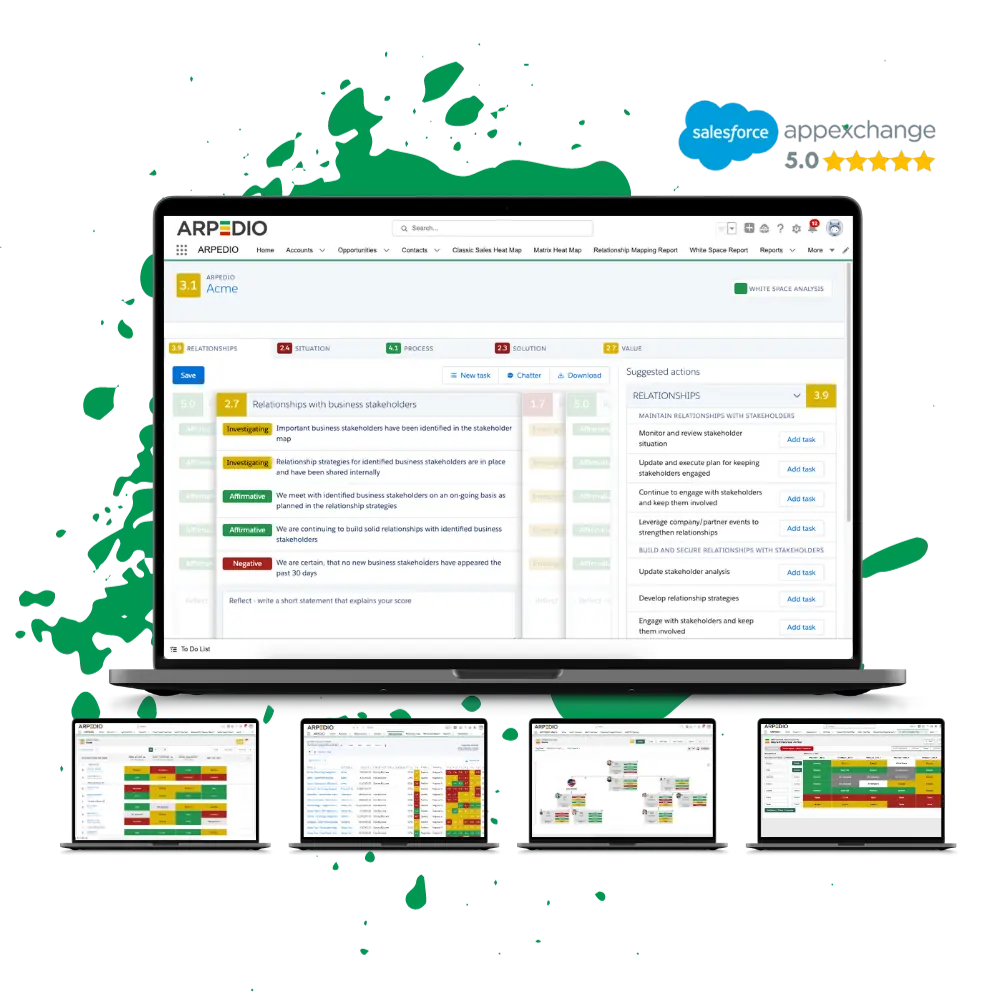In the competitive world of B2B sales, harnessing the power of an effective account mapping strategy is key to sales optimization and revenue growth. As businesses vie for market dominance, an articulate account strategy empowers organizations to deepen customer relationships and scale their operations effectively. Notably, in B2B sales environments, which are often characterized by complex dealings and a multitude of stakeholders, the implementation of astute B2B sales techniques is not just beneficial but essential for sustainable success.
This introductory section sheds light on the transformative potential that strategic account mapping holds in refining the sales approach and ultimately bolstering a company’s bottom line. By delving into a myriad of topics, from the principles of account mapping to its tactical application, this article serves as a beacon for professionals who aim to curate an enhanced and more targeted sales journey. Prepare to unlock the intricacies of account mapping and embark on a path to unmatched sales proficiency.
What is Account Mapping?
Account mapping is a strategic process used in sales and account management to visualize and understand the relationships within a customer account. It involves identifying key stakeholders, decision-makers, influencers, and their connections within the organization. By creating a visual representation or map of these relationships, businesses can better navigate their accounts, anticipate needs, and tailor their sales and marketing efforts to maximize opportunities for growth and retention. Essentially, account mapping helps businesses build stronger relationships and increase sales by providing insights into how to effectively engage with customers and meet their needs.
Understanding the Fundamentals of Account Mapping
The concept of account mapping basics may seem daunting at first, but it is essential for strategic account planning and overall sales enablement. Account mapping is a systematic approach to identifying and categorizing key accounts to customize sales strategies accordingly. This methodology not only assists sales teams in recognizing valuable opportunities but also helps them understand and align with client needs for sustainable growth.
At its core, account mapping is about laying the groundwork for a personalized and strategic approach to sales. One of the primary steps is dividing accounts into tiers based on their potential revenue, strategic value, or relationship complexity. Below is a visual guide that breaks down the typical tier structure in account mapping:
| Tier | Criteria | Focus Strategy |
|---|---|---|
| Tier 1 | High revenue potential, strategic importance | Customized solutions, dedicated resources |
| Tier 2 | Moderate revenue potential, growing accounts | Targeted engagement, relationship development |
| Tier 3 | Lower revenue potential but necessary for portfolio balance | Efficient, standardized approach |
Beyond mere classification, a visual representation is a game-changer in strategic planning. It offers clarity and insight into the sales landscape, indicating where to deploy resources and how to initiate strategic conversations.
Why does account mapping matter so much for sales teams? Because it translates complex customer data into actionable strategies. Sales representatives can leverage this information to tailor their approach, adjust their communication methods, and ultimately, close more deals effectively. It is a critical component of sales enablement, equipping teams with the knowledge and insights needed to perform their best in a competitive market.
- Clarifies the sales and client management landscapes
- Facilitates personalized and strategic engagement with key accounts
- Serves as a cornerstone for resource allocation and prioritization
- Enhances collaboration within sales teams through shared insights
In essence, account mapping is the backbone of a proactive sales strategy, supporting teams as they navigate the complexities of client relationships and market dynamics. By understanding and implementing the basics of account mapping, organizations are better positioned for success in their sales endeavors.
The Strategic Importance of Account Mapping in B2B Sales
Account mapping has become a lynchpin in B2B sales strategies, empowering organizations to gain an unprecedented view of their clients’ hierarchies and influence networks. By visualizing the connections between various stakeholders and recognizing the channels of decisive power, businesses can tailor their approach to resonate more deeply with the needs and the interests of each unique account.
Identifying Key Decision Makers
Central to the art of B2B sales is the capability to pinpoint the individuals who hold the authority to make purchasing decisions. Decision-maker identification not only streamlines the sales process but also amplifies the effectiveness of targeted communications, ensuring that key messages reach those who are instrumental in the buying cycle. This leads to more agile and strategic conversational entry points, fostering meaningful connections with the figures that matter the most.
Aligning Sales and Marketing Efforts
When sales and marketing teams operate in silos, the disconnection can lead to fragmented customer experiences and missed opportunities. Account mapping enhances marketing alignment by providing a shared view of an account, harmonizing messaging and tactics across departments. A unified strategy ensures that every engagement with a prospect builds on the last, creating a cohesive narrative that advances the customer journey towards a successful close.
Here’s how account mapping contributes to the convergence of sales and marketing:
- Content Customization: Specific understanding of account needs enables teams to tailor content that speaks directly to the pain points of each decision maker.
- Sales Enablement: Marketing resources are better leveraged when salespeople are equipped with insights derived from a comprehensive account overview.
- Metrics and Analysis: Shared data provides a foundation for both teams to measure campaign effectiveness and adjust strategies accordingly.
Forecasting Sales and Revenue Growth
One of the critical advantages of account mapping is its role in sales forecasting. With a clear grasp of the account landscape, sales teams can anticipate opportunities and risks, adjusting their focus to ensure steady revenue growth. Account mapping allows for a more methodical prediction of sales trends, factoring in potential deals and expansions, thus providing a more solid foundation for resource planning and business development strategies.
| Account Mapping Benefit | Impact on Sales Forecasting |
|---|---|
| Visibility into Key Contacts | Enables anticipation of deal closure based on decision-maker readiness |
| Understanding of Buying Centers | Improved prediction of cross-sell and up-sell opportunities within an account |
| Account Tiering and Prioritization | More accurate resource allocation to high-value prospects likely to convert |
| Insight into Relationship Networks | Ability to identify and leverage internal champions for advocacy |
At its core, account mapping underpins the strategic framework necessary for today’s intricate B2B landscapes, empowering businesses to drive impactful conversations, foster lasting relationships, and predictably steer the sales process towards successful outcomes.
Step-by-Step Guide to Implementing Account Mapping
Introducing account mapping implementation into an organization’s sales strategy requires methodical planning and execution. This section is a tailored guide designed to help businesses navigate through the intricacies of instituting a successful account mapping strategy. Beginning with the gathering of pertinent client data to devising a step-by-step sales strategy, each phase is built to bolster client portfolio management effectively.
Embarking on your journey, the following steps serve as foundation to creating a robust account map:
- Assemble comprehensive client information from various internal and external sources.
- Select criteria for segmenting accounts like size, industry, revenue potential, and strategic alignment.
- Visualize your account landscape to identify existing and potential high-value clients.
- Plot out the network of client relationships, recognizing key stakeholders and influencers.
- Integrate this map into your current sales processes to leverage strategic insights gained.
To consolidate these fundamental steps, the subsequent Account Mapping Table serves as a clear visual aid for businesses aiming to augment their sales strategies:
| Step | Action Items | Tools and Resources | Expected Outcome |
|---|---|---|---|
| 1. Data Assembly | Gather client data across touchpoints | Salesforce and ARPEDIO | Detailed client profiles |
| 2. Account Criteria | Define segmentation parameters | Market research, internal KPIs | Segmented client list |
| 3. Visualization | Create a visual representation of accounts | ARPEDIO | Actionable account landscape |
| 4. Relationship Mapping | Identify and document interactions | ARPEDIO Relationship Mapping | Clear view of network dynamics |
| 5. Process Integration | Embed account maps in sales process | Training sessions, process guidelines | Strategically aligned sales approach |
By adhering to this structured process, organizations can implement a powerful account mapping approach that adapts to their unique sales ecosystems. It enables targeted engagements with prospects and clients, ultimately driving sales and business growth.
Fostering an environment where step-by-step sales strategy and client portfolio management are at the forefront, businesses can use account mapping to not only understand their customers better but also to predict future opportunities and forge stronger relationships that yield long-term rewards.
Best Practices for Account Mapping Management
In the extensive and intricate world of B2B sales, managing an account map effectively can serve as a crucial lever for sustained revenue growth and optimal client engagement. Account mapping best practices are not merely recommendations but essential steps that underpin a robust sales strategy. Leaders in sales optimization keenly understand that incorporating these practices creates a competitive edge and ensures continuous alignment with evolving market demands.
Utilizing CRM Systems
CRM utilization sits at the heart of an efficient account mapping strategy. By leveraging Customer Relationship Management systems, organizations are empowered to harness a wealth of data that informs their account strategies. A dynamic CRM system, such as Salesforce combined with ARPEDIOs Account-Based Selling Platform, provides not only a centralized repository for account information but also offers analytic tools essential for drawing actionable insights. The role of CRM applications extends beyond mere data storage; they are vital for tracking the progression of relationships, identifying sales trends, and unifying communication across departments.
Maintaining Data Quality and Accuracy
Integral to the success of account mapping is the emphasis on data management. The quality and accuracy of data directly impact strategic decisions and the ability to personalize client interactions. Organizations seeking to implement account mapping must commit to stringent data collection and verification protocols. This means regular data cleansing, validation checks, and training personnel to understand the nuances of quality data – ensuring that every piece of information fed into the CRM is precise and thus reliable for decision-making.
Regular Review and Update Cycles
The dynamic nature of B2B sales necessitates the implementation of strategic review cycles. Account maps are not static tools; they require frequent revisions to stay aligned with changing client circumstances, market trends, and organizational objectives. Such reviews should be institutionalized process, where sales teams gather to critically assess and update account information. Incorporating these strategic review cycles allows a company to remain agile, responsive, and forward-thinking in its account mapping activities.












